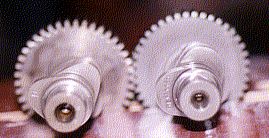Selecting the correct camshaft
for you bike can be confusing and frustrating. The more popular cams available may not be
the right cam for the way you ride or the type of bike you have. A cam that is installed
in a show bike featured by the 'biker' magazines may not be part of a proven engine performance
combination. When it comes to improving your bike's performance by installing a cam, you
should deal with a reputable performance shop and a proven record on improving power.

A stock cam is on the left, a 268 degree duration cam with a .600" lift is on
the right. |
In order to get the best performance, the
camshaft must be matched to all the other engine components. The combination of
carburetor, intake manifold, head design, flow characteristics, valve size, bore, stroke,
compression ratio, ignition system, exhaust system and the way you are going to ride the
bike all have an impact upon the best cam to select. If head work or pistons are not in
your budget, then your choices are limited to bolt-in cams. Even limiting your cam
selection to a bolt-in cam provides you with a wide choice of options. Most bolt-in
camshafts are intended for use with bikes and engines that have few modifications. The
minimum requirements for a bolt-in cam is usually a re-jetted carburetor, a high-flow air
cleaner and a less restrictive exhaust system.
Make sure you match your riding style or
needs to the the horse power and torque characteristics of the cam. The biggest mistake
made in cam selection is getting to much cam for the bike, the way it is ridden or the
components on the bike. A good set of pipes, some minor upgrades to the CV
carburetor, a good
ignition system and the right cam can produce around 75 HP when properly tuned.
| Bolt-in Cam Selector In order to simplify your
selection of a camshaft, the Motorcycle Performance Guide created a list of the most
bolt-in camshafts for Harley-Davidsons. Find the type of bike, the riding style and your
favorite cam manufacturer. A list of recommended camshafts is given. |
If you ride a heavy bike like a Road King
or always ride two up, you should place more emphasis on having the engine produce good
low end torque. If you have a light bike like an FXR or Dyna, and you want a lot of top
end power, a mid-range power cam can be used. If you usually ride your bike in town,
choose a camshaft for low end torque. If you have your choice between horsepower or torque
for engine characteristics, the best decision is to go for the torque cam.
As a general rule, cams with 220-235
degrees of duration tend to produce good low end torque. Cams with 235-250 degrees of
duration tend to work best in the mid-ranges and cams over 260 degrees work best for top
end power. Camshaft overlap duration less than 30 degrees tends to produce good low end
power. Lobe Separation Angles (LSA) of 100-103 degrees tend to produce power at the low
end.
Cams with valve lifts .500 inches and under, with
a duration
under 250 degrees are generally considered bolt-in. Cams over .500 inches lift and 250
degrees duration require increased compression and head work to work best.
Don't think you are going to take your stock bike
and turn it into a 100 HP monster by adding a cam, replacing the carburetor and putting on
straight pipes. Getting an 80 inch Big Twin engine to produce 100 horsepower at the rear
wheel is difficult, time consuming and quite expensive. You are much better off bolting in a
Crane Fireball 310, an Andrews EV-27 or a V-Thunder EVL-3010 in your street bike than
trying to find a long duration cam because you have been told 'bigger' cams makes more
horsepower. A well designed and tuned engine combination, using a mild bolt-in cam is quite
capable of embarrassing most other Harley's between stoplights. 100 horsepower is not very
useful if the engine does not make power until 6000 RPM. Harley-Davidson Big Twin engines
were not designed to take that kind of abuse. An engine with 70 HP at 4800 RPM and 85 foot
pounds of torque at 3200 RPM can be a real thrill compared to a stock EVO motors. |